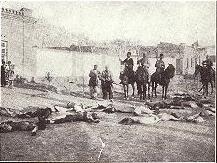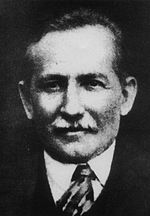Portal:Assyrians
|
||||||||||||
|
The Assyrians Portal
The Assyrian people (originally and most commonly known as Assyrians and other later variants of the name, such as; Syriacs, Syriac Christians, Suroye/Suryoye, Chaldo-Assyrians, see names of Syriac Christians) are a distinct ethnic group with continuity since antiquity living in the Assyrian homeland in northern Mesopotamia. They have been minorities under other ethnic groups' rule since late antiquity. Today that ancient territory is part of several nation states, namely northern Iraq, northwestern Iran, northeastern Syria and southeastern Turkey. In the 21st century, Assyrians entertain numerous civil society organizations and political parties in the two countries of their largest presence, Iraq and Syria.
Assyrians generally identify with Syriac Christianity in the East Syrian Rite (Ancient Church of the East, Assyrian Church of the East, Syriac Orthodox Church, Chaldean Catholic Church). While some Assyrian communities practice the West Syrian Rite, the latter is also practiced by Syriac Christians in Western Syria who are not ethnic Assyrians (e.g. Maronites, Syrian Jacobites). Many have migrated to the Caucasus, North America, Australia and Europe during the past century. Diaspora and refugee communities are based in Europe (particularly Sweden, Great Britain, Denmark, Germany and France), North America, Australia, New Zealand, Lebanon, Armenia, Georgia, southern Russia and Jordan. Such Emigration was triggered by such events as the Assyrian genocide in the wake of the First World War during the breakup of the Ottoman Empire, the Simele massacre in Iraq (1933), the Islamic revolution in Iran (1979), Arab Nationalist Baathist policies in Iraq and Syria, the Al-Anfal Campaign of Saddam Hussein and to a large degree Kurdish nationalist policies in northern Iraq. Most recently the Iraq War has displaced the regional Assyrian community, as its people have faced ethnic and religious persecution at the hands of both Sunni and Shia Islamic extremists and Arab and Kurdish nationalists. Of the one million or more Iraqis reported by the United Nations to have fled, nearly forty percent (40%) are Assyrian, although Assyrians comprise only three percent of the Iraqi population. Selected article
The Assyrian Genocide,(also known as Sayfo or Seyfo, ("Sword") Syriac: ܩܛܠܐ ܕܥܡܐ ܣܘܪܝܝܐ or ܣܝܦܐ) refers to the mass slaughter of the Assyrian/Chaldean/Syriac population of the Ottoman Empire during the First World War. The Assyrian population of northern Mesopotamia (the Tur Abdin, Hakkari, Van, Siirt regions of present-day southeastern Turkey and the Urmia region of northwestern Iran) was forcibly relocated and massacred by Ottoman (Turkish) and Kurdish forces between 1914 and 1920. Estimates on the overall death toll have varied. Contemporary reports placed the figure at 270,000. More recent estimates have revised that figure to as between 500,000 and 750,000. The Assyrian genocide took place in the same context as the Armenian and Pontic Greek genocides. In these events, close to three million Christians of Syriac, Armenian or Greek Orthodox denomination were murdered by the Young Turks regime. Since the "Assyrian genocide" took place within the context of the much more widespread Armenian genocide, historical scholarship treating it as a separate event is scarce. In 2007, the International Association of Genocide Scholars reached a consensus that "the Ottoman campaign against Christian minorities of the Empire between 1914 and 1923 constituted a genocide against Armenians, Assyrians, and Pontian and Anatolian Greeks." The President of Genocide Watch endorsed the "repudiation by the world's leading genocide scholars of the Turkish government's ninety-year denial of the Ottoman Empire's genocides against its Christian populations, including Assyrians, Greeks, and Armenians." Selected picture
Although Assyrians (Syriacs) were completely exterminated or driven out of the city of Mardin in south eastern Turkey during the Assyrian Genocide in 1915, some monasteries managed to survive. Here appears Mor Severios Abraham, the abbot of a small monastery in the area. Categories
Assyrians news
Selected biography
Naum Elias Yaqub Palakh (February 1868 – February 5, 1930), better known as Naum Faiq (Syriac: ܢܥܘܡ ܦܐܝܩ, Naˁum Fayëq) was one of the founding fathers of modern Assyrian nationalism during the early 20th century. He was a teacher and writer throughout his life. A Syriac Orthodox Christian, he emphasized the importance of unity among Assyrians and encouraged his community to depart from "tribal mentality." He was born in Amid (present day Diyarbakir) in the Ottoman Empire and began his education there at the age of seven. After primary school, he attended the local high school that had been established by local "Brotherhood of Ancient Syrians". He spent 8 years at the school, where education was jointly in classical Syriac, Ottoman Turkish and Arabic. Naum also went on to learn several other languages, including Persian and basic French. After his parents died, he first lived with his older brother Thomas and then started teaching in a village near Diyarbakır in 1888. He also taught in Urfa, Adıyaman and Homs before returning to Diyarbakır. Naum wrote numerous books concerning the Syriac language and people. After the 1908 Young Turk Revolution and the proclamation of the second Ottoman constitution, restrictions on freedom of speech were lifted. In 1910, Naum began publishing a newspaper for the Orthodox, Catholic and Protestant Syriac communities, entitled Kawkab Madnho ("Star of the East"). While written entirely in the Syriac alphabet, Star of the East was actually tri-lingual with articles in Ottoman Turkish, classical Syriac and Arabic. This newspaper, along with that of Ashur Yousif, signaled the emergence of Assyrian nationalism in the Syriac Christian communities of the Ottoman Empire. Did you know ...
Featured Content
Topics
Related portals
Associated Wikimedia
|









